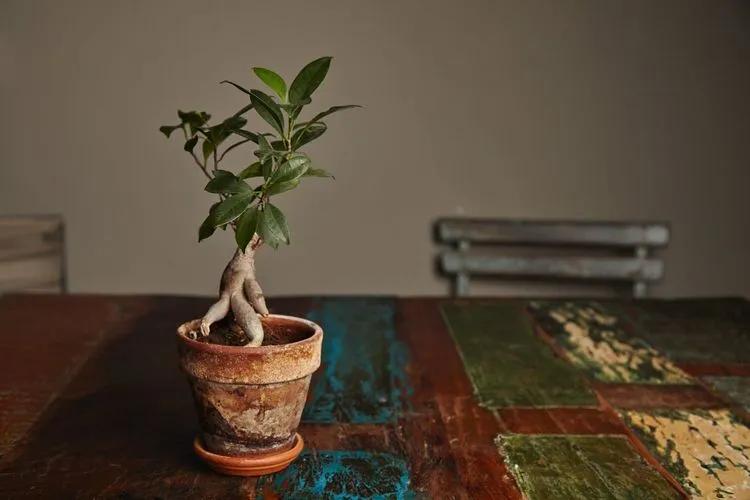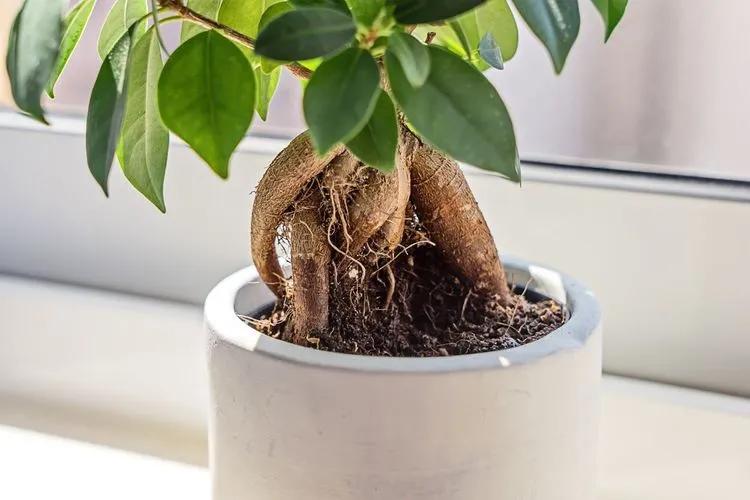Ficus bonsai
Bonsai is an ancient method of arranging plants to make them look like a mini-version of a mature tree. You can try almost any plant for this art, but species of the Ficus genus, also known as mulberry plants or Moraceae, are the optimal choice for bonsai beginners. So what are the peculiarities of growing a ficus bonsai?
Overview
 There is a misbelief that bonsai trees are something like “dwarf” trees, but this is not true - these are normal-size plants that get miniature and at the same time mature look by applying special care. A young plant is taken as a basis, and in the process of growth, a root system and foliage are formed by pruning. Thus, almost any species might be grown as bonsai -almost because not all of them respond well to regular pruning.
There is a misbelief that bonsai trees are something like “dwarf” trees, but this is not true - these are normal-size plants that get miniature and at the same time mature look by applying special care. A young plant is taken as a basis, and in the process of growth, a root system and foliage are formed by pruning. Thus, almost any species might be grown as bonsai -almost because not all of them respond well to regular pruning.
We recommend starting with weeping fig or ficus benjamina. This plant is easy to care for, grows quickly, has small delicate leaves and relatively massive roots and stems. It tolerates multiple pruning, which is probably the most significant aspect.
Planting
For planting bonsai, choose a special wide, shallow container. Make large drainage holes in it (two times more than those you make for ordinary indoor plants). It is better if the container has “legs”; this will ensure better drainage. Cover the bottom of the container with a mesh before planting. Add a drainage layer and top it with the soil. Place the plant with pre-cut roots, fill it with the soil to the level of the root collar. After planting, tamp the soil. Make sure that the soil level is always slightly below the edges of the container.
Lighting
Weeping fig thrives in lots of bright, diffused light. This plant is actually so undemanding that it can even grow in direct sunlight - but in this case, let your green pet acclimate. If placed in direct sunlight without “training,” it might get sunburns. In summer, it can be bright outside.
Temperature
Weeping fig prefers temperatures above 15°C (59˚F). It can survive short periods in lower temperatures, but the ideal conditions are around 23˚C (75˚F) during the day and 18˚C (65˚F) at night. As for the summer heat, ficus benjamina will make it if you water it regularly. Avoid cold drafts - they will harm the plant.
How to form a beautiful crown
 Forming a bonsai crown of a weeping fig is a creative process. You need to cut off all the branches that are knocked out of the general shape. Trimming should be done with a sterile and very sharp tool. Start from the bottom of the crown and move upwards to the top. Form the foliage into a crown shape similar to regular trees.
Forming a bonsai crown of a weeping fig is a creative process. You need to cut off all the branches that are knocked out of the general shape. Trimming should be done with a sterile and very sharp tool. Start from the bottom of the crown and move upwards to the top. Form the foliage into a crown shape similar to regular trees.
Keep in mind that in autumn and winter, plant growth slows down, unlike in spring and summer. To maintain the shape of the crown, it is better to prune it during the period of late winter and early spring. Ficuses tolerate pruning well, so don't be intimidated by this process.
To reduce the size of the leaves, simply pinch them with small scissors. The procedure is done during the summer months to maintain the shape of the tree. Similarly, cut off the roots to form a thick strong trunk. This should be done while the plant is still young, about a year. Cutting the roots, the tree begins to grow in width. You can trim up to one third of the root system. Once again, use only sterile and very sharp equipment. Do not worry: while the procedure is harmless to the ficus, it helps to accelerate the preferable growth of the plant.
Watering
Weeping fig is a tropical plant which loves moisture - thus, it should be watered frequently. However, do not overwater it - the soil should not be wet all the time. It is possible to stimulate the growth by watering bonsai with water of 40°C (104˚F).
Fertilizing
In summer, fertilize the ficus once every one to two weeks, and in winter, every two to four weeks (if the tree continues to grow). Liquid fertilizers can be used in combination with granular organic fertilizers. Dilute the recommended dose of fertilizer in two.
Common issues
 Weeping fig is not prone to diseases, dropping leaves is the most common issue its owners face. The most significant reasons for dropping leaves include:
Weeping fig is not prone to diseases, dropping leaves is the most common issue its owners face. The most significant reasons for dropping leaves include:
- lack of moisture
- drafts and plant rearrangements,
- sudden changes in temperature,
- small amount of light.
Remember that it is always better to avoid the problem than to deal with it. Take care of your bonsai tree and it will provide you with positive emotions and unique atmosphere.
Do not hold back, create, create your perfect bonsai style ficus. Observe the growing conditions, take care of it, and an attractive magic tree will appear in your home. It will take a long time, but as a result, you will understand how rewarding and meditative the art of bonsai is!
